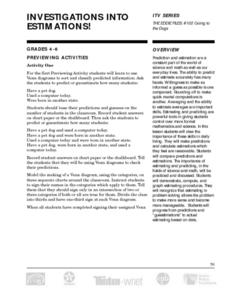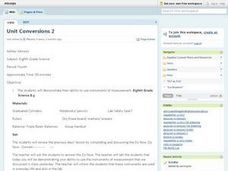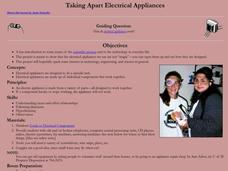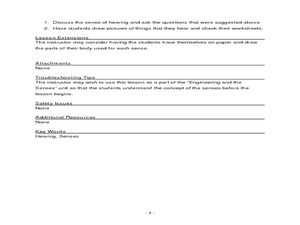Curated OER
Eye Spy
Fourth graders study the functions of the human eye and how it processes information.
Curated OER
Investigations into Estimations
Students gain the powerful tools of estimation, prediction, and averaging and discover the importance these tools have in daily living.
Curated OER
All Hands on Deck: A Harbor Education Program
Students build a model of an estuary. In this wetland lesson, students build a model estuary with a paint tray and modeling clay. They use the model to illustrate the impact of non-point pollution on the watershed.
Curated OER
Simple Machines
Students research simple machines. In this simple machines lesson, students explore the many types of simple machines such as the lever, pulley, and screw. Students discover simple machines in the classroom.
Curated OER
Observing and Predicting Weather from a Weather Station
Fourth graders us a Weather Log data chart to record the date, time, day, and weather. They discuss different instruments and charts needed to record the information. Students turn in their weather logs at the end of two weeks and...
Curated OER
What is electrical energy?
Students distinguish between items with and without energy. In this energy lesson, students understand that natural resources power electrical apparatus and that energy needs to be saved.
Curated OER
In the Eye of the Storms
Tenth graders study the major hurricanes of the Atlantic Ocean. In this weather lesson plan, 10th graders read an article and answer various questions. Students discuss their findings with their classmates.
Curated OER
Thinking about Energy
Young scholars examine their understandings about energy concepts by completing an online survey. Students participate in a class discussion about their uses of resources and the differences between perpetual, renewable, and...
Curated OER
Current Thinking About Magnets
Students construct their own magnet and wire device. In this inquiry instructional activity, students investigate the factors affecting the strength of magnetic forces. They manipulate different variable to determine their effect.
Curated OER
America's Pastime
Students relate Newton's Laws of Motion to the game of baseball. They compare and contrast the materials used in baseballs that could affect their performance. They also determine how friction can be increased or decreased in a ballpark.
Curated OER
Introduction to Materials: Properties of Materials
Pupils explore the properties of matter. In this properties of materials lesson plan, students examine wood, metal, rubber, Styrofoam, and plastic. Pupils identify the attributes of each of the materials.
Curated OER
Measuring Snowfall
Students predict the amount of snowfall for the week and measure snowfall. In this measuring snowfall instructional activity, student use a precipitation gauge to measure the week's snowfall; and analyze the data to determine...
Curated OER
Build an Anemometer
Students investigate wind speed. In this wind instrument activity, students build an anemometer to measure wind speed and discuss the importance of wind speed knowledge in various professions.
Curated OER
Comparing the Satellite and Broadcast Radio Landscapes
Students research the development of satellite technology over the last 50 years students explain how the enactment of the Telecommunications Act of 1996 changed the rules for corporate ownership of multiple media outlets.
Curated OER
Ramp and Review
Learners participate in an activity in which they observe a ball as it rolls down an incline into a cup. They take measurements and use equations that describe the concepts of mechanical energy, work and power, momentum, and friction. ...
Curated OER
Seesaws
Students make direct comparisons between objects using balance and spring scales. They also are encouraged to estimate which object is heavier by holding the objects before using the balance scales. Comparing the masses of objects is the...
Curated OER
Unit Conversions 2
Eighth graders demonstrate the use of instruments of measurement. As a class, they take notes and observe the proper procedure for using a graduated cylinder, a ruler, and a balance/triple beam balance. In groups, 8th graders visit...
Curated OER
Taking Apart Electrical Appliances
Students apply the scientific method to the act of taking apart appliances. In this scientific process lesson plan, students disassemble appliances to learn how their components work together.
Curated OER
Clay Sculpture: Relationships
Students explore art history by conducting an in-class activity. In this sculpting lesson, students examine previously created art sculptures in a textbook. Students utilize clay, sculpting tools and grey paper to create their own...
Curated OER
Hold Off on the Headphones
Students explore hearing loss caused by sound waves. In this physical science lesson plan, students will start by learning about waves and wave characteristics and move into sound waves. Students will study how sound effects their...
Curated OER
Living in a Watershed
Fourth graders examine watersheds. In this ecosystem lesson, 4th graders discover what a watershed is and identify the local watershed they live in. Students investigate the attributes of a watershed as well.
Curated OER
Engineering and the Senses: Hearing
Students explore the sense of hearing. In this 5 senses lesson plan, students consider how humans and animals use the sense of hearing along with their other senses. Students discuss the body parts responsible for the 5 senses...
Curated OER
Here It Comes, There It Goes!
Students use an ordinary toy to reveal the Doppler effect. The connection is also made to moving cars, and to the shifting of the lines in the absorption or emission spectrum when the distance between a star and Earth is increasing or...
Curated OER
The Last Great Canal
Students read about a cholera outbreak in the 1840's. They read maps, predict how cholera moved throughout the country and participate in a lab activity that demonstrates how disease is spread. They compare cholera through time.























